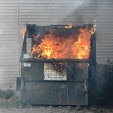The 1D Mark III and 1Ds Mark III each had one Compact Flash and one SD card slot, but the contemporary 5D Mark II only had the CF slot. Similarly, Nikon's pro D3 had a brace of CF slots, but the D700 only had the one.
Stepping down from full frame to crop sensor, the Canon EOS 40D and Nikon D300 only had one CF slot. Likewise, the Pentax K20D, which was the top digital Pentax of the time, had a lone SD card slot for storage.
Only the Sony a700 and Olympus E-3 had a pair of card slots among the cameras in this tier, but that's for a specific reason. See, both Sony and Olympus had their own in-house memory card formats, so their DSLRs had one slot for Compact Flash and one for Sony Memory Stick (on the a700) or xD (on the E-3).
 |
| The card slots on an Olympus E-3 |
Unlike the dual slots on the pro Nikon and Canon cameras, you couldn't record to both of these cards at the same time, it was strictly one or the other.
It wouldn't be until later, in cameras like the Nikon D300S and D7000 that Nikon let dual card slots trickle down, and Canon users had to wait for the 5D Mark III and 7D Mark II.

2 comments:
Just a quick comment on the K20D...it's got a top-end limit on the storage size of the SD cards it will take; 32GB (if I remember) is about it.
I bought some nice wide neoprene straps for my cameras that have two tiny little velcro-closure pockets near the ends which are perfectly sized to carry my spare battery in one, and a micro-fiber lens cloth and spare SD card (all plastic-wrapped) in the other.
Yeah, I keep a supply of smaller SD and CF cards around for my older bodies for just that reason.
Post a Comment